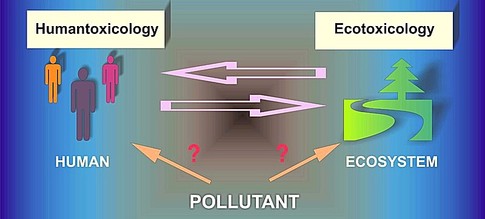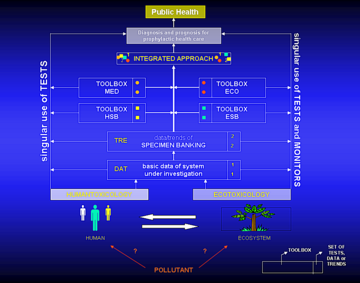Multi-Markered-Bioindication-Concept (MMBC) related to Human Health
An integrated toolbox model for prophylactic human health care
condition
Bioindication and biomonitoring must supply information on the degree of pollution or degradation of ecosystems. For integrative approaches bioindication is not an “environmental monitoring machine” for a specific constellation of factors; ideally, it is an integrated consideration of various bioindicative test systems which attempts, in conjunction with other environmental parameters, to produce a definite picture of a pollution situation and its development in the interests of prophylactic care of health and the environment.
The following illustration is a diagram of a complete dynamic environmental monitoring system supported by bioindication. It can re-combine its measurement parameters according to the particular system to be monitored or the scientific frame of reference. The two main subjects of investigation - man and the environment - and the disciplines human toxicology and ecotoxicology derived from them are associated with various “toolboxes” and sets of tests (“tools”, eg bioassays) for integrated environmental monitoring (Markert et al. 2003).
[please click on the figure]
Figure: Possible hierarchical structure of a bioindicative toolbox model for integrative approaches in human- and ecotoxicology. The toolboxes MED and ECO contain single sets of tests that can be combined functionally to allow an integrated approach to the particular frame of reference or a specific scientific problem. The toolboxes HSB (human specimen banking) and ESB (environmental specimen banking) represent years of results from international environmental sample banks specializing in environmental and human toxicology; in addition to MED and ECO they provide important information on the ecotoxicological and human-toxicological behavior of environmental chemicals. In the integrated approach, all the results obtained singly are substantiated by existing basic data available from (eco-)systems research, toxicology and environmental sample banks. The parameter constellations necessary for this are taken from the toolboxes TRE and DAT (Markert et al. 2003).
The system shown in the figure above consists of 6 toolboxes. The first two are derived mainly from environmental research: DAT (for data) and TRE (for trend). DAT contains, as a set, all the data available from the (eco-)system under investigation, ie including data acquired by purely instrumental means, for example from the meteorological sphere. DAT also contains maximum permissible concentrations of substances in drinking water, food or air at the workplace and the data for the relevant ADI (Acceptable Daily Intake) and NO(A)EL (No Observed (Adverse) Effect Level). The toolbox TRE contains data on trends; these have been compiled mainly from years of investigations by national environmental sample banks, or information available from long-term national and international studies (eg Duvigneaud & Denayer-De Smet 1973; Ellenberg et al. 1986; Likens et al. 1977).
Specific conclusions and trend forecasts can then be prepared using the subsequent toolboxes HSB (Human Specimen Banking) and ESB (Environmental Specimen Banking) (see also Kettrup 2002). The toolbox MED (medicine) contains all the usual methods employed in haematological and chemical clinical investigations of subchronic and chronic toxicity, whereas ECO is largely made up of all the bioindicative testing systems and monitors relevant to ecosystems which may be combined to suit the particular situation to be monitored.
The data from all the toolboxes must interact with each other in such a way that it is possible to assess the average health risk for specific groups of the population or determine a future upper limit of risk from pollutants by forming networks. This risk assessment ultimately makes use of all the toxicological limits that take the nature of the effect and dose-effect relationships into account according to the current status of scientific knowledge.
Since toxicological experiments cannot be carried out on human beings, recourse has to be made to experience at the workplace and cases of poisoning in order to permit an evaluation and risk assessment. Besides examining reports on individual cases, greater efforts must be made to reveal the effects of substances as a cause of disease by means of epidemiological surveys with exposed groups as compared with a control group. The development and use of simulation models supported by information technology, taking all the data collected into account, will play an important role here, since a large number of parameters that do not interact directly have to be combined. They include various data from the field of epidemiology, from mutagenicity studies, toxicokinetics, metabolism research and structure-effect relationships.
The conclusions of such networking in between different tool boxes can be used for a whole concept of bioindication in general, outlined in the so-called Multi-Markered-Bioindication-Concept (MMBC), which is outlined in Markert et al. (2003, 2004, 2008).










